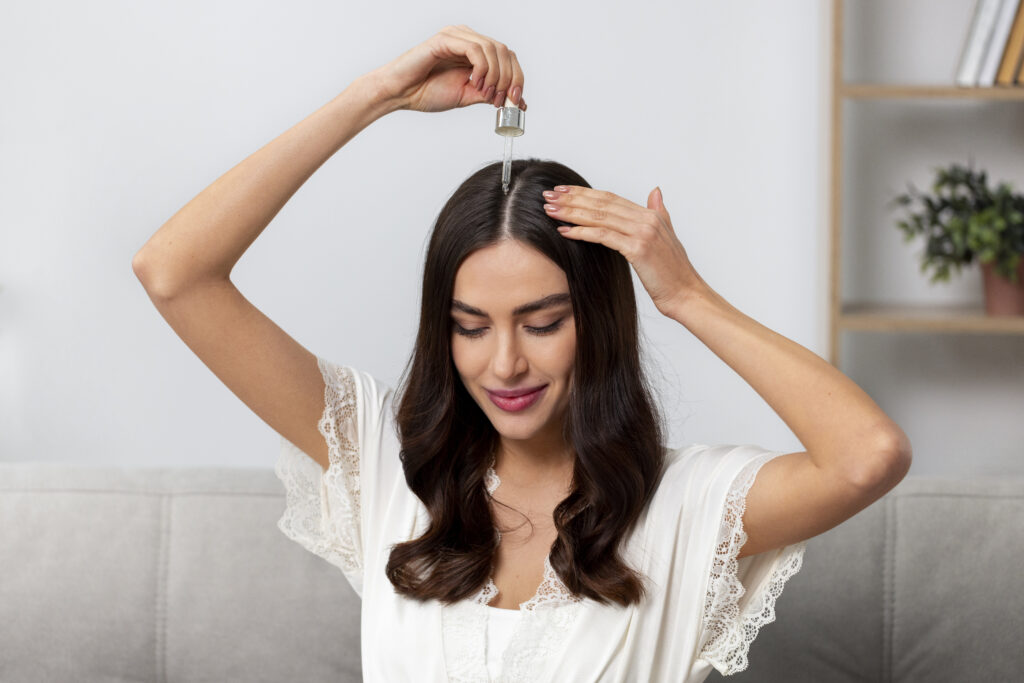
With origins in natural hair care and Ayurveda, hair oiling is a long-standing custom. If done correctly, it’s easy, inexpensive, and very effective. The problem is that a lot of individuals use oil improperly, which results in accumulation, oily hair, and no actual benefits. This article will teach you how to properly apply hair oil, what kinds to use, how long to leave it in, and how frequently to oil your hair.
1. Why Hair Oiling Works
From the roots to the tips, hair oiling nurtures your hair. It
makes hair follicles stronger
decreases split ends and breakage
adds smoothness and luster.
encourages blood flow to the scalp
can stop dryness and dandruff.
However, these advantages only become apparent when you employ the appropriate method and oil for your hair type.
2. Choose the Right Hair Oil for Your Hair Type
For various purposes, different oils are effective. Here are few instances:
All hair types benefit greatly from coconut oil, but dry and frizzy hair in particular. It goes deep into the shaft.
Vitamin E-rich almond oil is ideal for hair that has been chemically treated or damaged.
Thick and perfect for strengthening roots and encouraging hair development is castor oil.
Lightweight and ideal for adding shine without being greasy, argan oil is ideal for fine hair.
Jojoba oil: Excellent for oily or acne-prone skin, it’s the closest natural oil to scalp oils.
Ayurvedic mixtures for hair growth, stress reduction, and scalp health are known as bhringraj or brahmi oils.
3. Step-by-Step Guide to Applying Hair Oil Correctly
Here’s how to do it right:
First, untangle Initially
To get rid of knots, lightly brush your hair. This guarantees equal distribution and eliminates breakage during oil application.
Step 2: Warm the oil (recommended but optional)
Absorption is slightly increased by warming the oil. After putting the oil in a bowl, fill it with warm water. Microwaves can damage nutrients, so avoid using them.
Step 3: Create Sections in Your Hair
Using clips, divide your hair into four to six portions. This guarantees even coverage and facilitates access to your scalp.
Apply to the Scalp in Step Four Initially
Apply oil directly to the scalp with your fingertips or a cotton ball. Use gentle circular strokes to massage. Pay attention to the scalp as well as the hair shaft.
Spend at least five to ten minutes massaging. This promotes blood flow and facilitates the delivery of nutrients to hair roots.
Apply to Hair Length in Step Five
Apply oil all the way down your hair after the scalp. To distribute the oil evenly, use a wide-tooth comb or your fingers.
Extra oil should be applied to cracked or dry ends.
Wrapping Your Hair in Step Six
Put on a shower cap or wrap your hair in a warm towel. This helps the oil penetrate deeper and retains heat.
4. How to Wash Off Hair Oil Properly
A typical error that results in greasy, limp hair is improperly washing out the oil.
The trick is this:
Directly apply shampoo to oiled, dry hair. Applying it without any water aids in the breakdown of the oil.
Lather up by adding a little water.
Rinse well, and if necessary, shampoo again.
If the ends of your hair still feel dry, use a mild conditioner.
Steer clear of hot water as it depletes the hair’s natural oils and may result in dryness.
5. How Often Should You Oil Your Hair?
Your hair type and routine will determine this:
Curly, dry, or damaged hair: two to three times per week
Typical hair: a couple of times per week
Oily scalp: No more than once per week
Excessive oiling might cause accumulation or closed scalp pores. To avoid scalp problems, cut back on how often you work out or perspire.
6. When to Avoid Hair Oiling
In some circumstances, oiling can be more detrimental than beneficial:
Oil might exacerbate fungal infections if you have fungal-induced dandruff.
It may clog pores if you have extremely oily skin or acne on your scalp.
Wait two to three days before oiling your freshly dyed hair.
Always start by evaluating the state of your scalp.
7. Pro Tips for Better Results
Don’t oil dirty hair. Always apply to clean or relatively clean hair for better absorption.
Use a scalp massager tool for even better stimulation.
Steam your scalp after oiling to open pores and boost penetration.
Don’t overuse oil. More oil doesn’t mean more benefits. Use just enough to coat the scalp and strands.
Use silk or satin pillowcases if sleeping with oiled hair overnight.
9. Summary: Do’s and Don’ts
✅ Take action: Before application, slightly warm the oil.
Pay attention to the scalp first, then the hair.
For improved circulation, give yourself a little massage.
Give it a minimum of one hour.
Use a gentle shampoo to give it a thorough wash.
❌ Avoid putting oil on sweaty or unclean hair.
Excessive oil use causes accumulation.
Keep the oil in for longer than twenty-four hours.
When massage, rub vigorously.
After oiling, forego shampooing.
conclution
Even though hair oiling is easy, the method is crucial. Hair that is healthier, shinier, and stronger can be achieved by selecting the appropriate oil, applying it appropriately, and understanding when to rinse it out. Don’t overdo it, follow a regular schedule, and pay attention to your scalp’s needs. Long-term results are achieved through consistency.